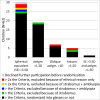Baseline characteristics of children in the Early Glasses Study
- PMID: 39235501
- PMCID: PMC11868130
- DOI: 10.1007/s00417-024-06621-8
Baseline characteristics of children in the Early Glasses Study
Abstract
Purpose: The relationship between refractive error at age 1 and the risk of developing amblyopia or accommodative esotropia, and the protection offered by early glasses, is unknown. These are determined in the Early Glasses Study, a prospective, population-based, longitudinal, randomized controlled study. We report baseline findings.
Methods: Healthy children aged 12-18 months were recruited at Children's Healthcare Centres (CHCs) and received an entry orthoptic examination followed by cycloplegic retinoscopy. Children with amblyopia, strabismus, ophthalmic disease or very high refractive error were excluded. Those exceeding the AAPOS 2003 Criteria (> + 3.5D spherical equivalent (SE), > 1.5D astigmatism, > 1.5D anisometropia) were randomized into wearing glasses or not, and are followed-up by research orthoptists. Other children are followed-up by regular vision screening at CHCs and visual acuity is measured in all children at age 4.
Results: Parents of 865 children were called, 123 were excluded. Of 742 children enrolled, 601 underwent the entry orthoptic examination at age 14.5 ± 1.7 months. Mean SE was + 1.73 ± 1.18D, astigmatism -0.70 ± 0.44D, anisometropia 0.21D (IQR: 0-0.25). Of 62 (10.3%) children exceeding the Criteria, 52 were randomized into wearing glasses or not. Of 539 other children, 522 are followed up at CHCs. In total, 31 were excluded: 2 had strabismus and amblyopia, 7 strabismus, 2 amblyopia suspect, 1 strabismus suspect, 1 squinting during sinusitis, 4 excessive refractive error, 9 myopia, 2 ptosis, 1 oculomotor apraxia, 1 Duane syndrome, 1 congenital nystagmus.
Conclusion: Prevalence of strabismus (10/601) was as expected, but prevalence of amblyopia (2/601) was low, suggesting that common amblyopia develops later than generally thought.
Key messages: What is known High refractive errors cause amblyopia, but no study has determined the exact relationship between the kind and size of refractive error at age 1 and the risk to develop amblyopia, and assessed the protective effect of glasses in a controlled, population-based, longitudinal study. What is new At baseline, 601 children received a full orthoptic examination followed by retinoscopy in cycloplegia at the age of 14.5 ± 1.7 months; 10.3% had high refractive error exceeding spherical equivalent > + 3.5D, > 1.5D astigmatism, > 1D oblique astigmatism or > 1.5D anisometropia. The prevalence of amblyopia was lower (0.3%) than expected, suggesting that most amblyopia develops after the first year of life. The prevalence of anisometropia, associated with amblyopia in older children, was low (0.8%).
Keywords: Accommodative estropia; Amblyopia; Anisometropia; Astigmatism; Glasses; Hypermetropia.
© 2024. The Author(s).
Conflict of interest statement
Declarations. Ethics approval: The study was approved by the Medical Ethics Review Committee (MERC) of the Erasmus University Medical Center on April 30th, 2021, and was carried out in accordance with the ethical conduct and juridical laws laid down in the Declaration of Helsinki, version 2013. Consent to participate: All parents of enrolled children were required to provide written consent by both parents or legal representative or guardian prior to the Entry Orthoptic Examination. Consent for publication: Not applicable, all data is presented anonymously. Conflict of interest: The authors have no relevant financial or non-financial interest to disclose.
Figures





References
-
- Groenewoud JH, Tjiam AM, Lantau VK et al (2010) Rotterdam AMblyopia screening effectiveness study: detection and causes of amblyopia in a large birth cohort. Invest Ophthalmol Vis Sci 51:3476–3484. 10.1167/iovs.08-3352 - PubMed
-
- Sloot F, Karaman H, Sami S et al (2016) Disinvestment of population-wide eye screening at age 6–24 months in the Netherlands. Invest Ophthalmol Vis Sci 56(7):5209
-
- Abrahamsson M, Fabian G, Andersson AK et al (1990) A longitudinal study of a population based sample of astigmatic children I Refraction and amblyopia. Acta Ophthalmol 68:428–434. 10.1111/j.1755-3768.1990.tb01671.x - PubMed
Publication types
MeSH terms
LinkOut - more resources
Full Text Sources
Medical

